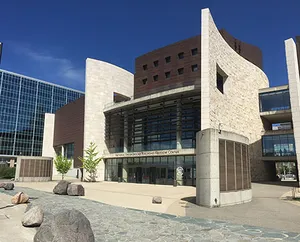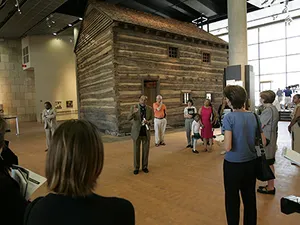
The National Underground Railroad Freedom Center is a museum in Cincinnati, Ohio, that tells the story of freedom’s heroes from the era of the Underground Railroad to today. The Underground Railroad was a secret network of routes, people (“conductors”), and safe houses (“stations”) that helped enslaved people in the Southern United States escape to freedom.
Research your ancestors on MyHeritage
History of the National Underground Railroad Freedom CenterHistory of the National Underground Railroad Freedom Center
The National Underground Railroad Freedom Center opened in 2004 on the banks of the Ohio River in downtown Cincinnati. As the pre-Civil War boundary between states where slavery was legal and states where it was illegal, the river symbolized freedom to many slaves escaping via the Underground Railroad.
During the museum’s first year in operation, 280,000 people visited from all 50 U.S. states and 35 countries.[1]
National Underground Railroad Freedom Center exhibitsNational Underground Railroad Freedom Center exhibits

Exhibits at the National Underground Railroad Freedom Center share history about slavery, the Underground Railroad, and modern abolition movements trying to end forms of slavery that still exist. Permanent exhibits include:
- Suite for Freedom Film: This film in the Harriet Tubman Theater shares stories about freedom, "UnFreedom" (slavery), and the Underground Railroad. The ceiling is lighted to reflect the formation of stars on Jan. 1, 1863, the date President Abraham Lincoln signed the Emancipation Proclamation.
- ESCAPE! Freedom Seekers and the Underground Railroad: This family-friendly, interactive exhibit introduces the Underground Railroad.
- Brothers of the Borderland Film: This film in the Boeing Flight to Freedom Theater is about Underground Railroad conductors John Parker and Rev. John Rankin.
- From Slavery to Freedom: This exhibit focuses on the Middle Passage, the institution of slavery, the rise of abolitionism, and the Civil War.
- The Slave Pen: This authentic log cabin, once owned by a Kentucky slave broker, was used to hold enslaved humans before they were transported to Southern markets for sale.
- The Struggle Continues: This exhibit examines the forms of slavery that continue to exist.
- Open Your Mind: Understanding Implicit Bias: This exhibit educated visitors about unconscious biases that affect the ability to be inclusive.[2]
The National Underground Railroad Freedom Center website also hosts traveling exhibitions and special events.
Genealogy research at the National Underground Railroad Freedom CenterGenealogy research at the National Underground Railroad Freedom Center
The John Parker Library and FamilySearch Center is located on the museum’s fourth floor. It offers free access to genealogy resources and online searchable databases, including MyHeritage. Library volunteers can show you how to use the resources and recommend resources that may be helpful for your research.
Making an appointment is strongly recommended for anyone planning to visit the library. See the John Parker Library and FamilySearch Center web page for contact information and current library hours.
When you visit, bring any family history information you know, such as names and birth and death dates and places of your parents, grandparents, and great-grandparents.
The library does not have records documenting individual conductors or stations on the Underground Railroad. Few records exist because of the secretive nature of the network. To research the Underground Railroad, the library staff recommend using local histories and other books, consulting oral histories, and contacting state and county historical societies.[3]
National Underground Railroad Freedom Center online exhibitsNational Underground Railroad Freedom Center online exhibits
The National Underground Railroad Freedom Center website links to several online exhibits, including:
- Discover the Transatlantic Slave Trade to the 13th Amendment: Explore the journey of enslaved people who were part of the Transatlantic Slave Trade.
- A Slave Pen Journey: Learn about the journey of enslaved persons purchased and sold by John W. Anderson, who owned the slave pen now located inside the Freedom Center.
- Rachel at Longwood: The Wallace House of Covington, Kentucky: Learn about a slave owning family in Covington, Ky., just across the river from Cincinnati.
- Cincinnati’s Soldiers: Men and Women in the First World War: Learn the stories of local heroes.
- My Dear Wife, I Love You: Charles Lewis in World War II: Read letters from a WWII soldier to his wife in Cincinnati.
- Voices blog: This blog includes posts about Black history, current events, and archival research.[4]
How to visit the National Underground Railroad Freedom CenterHow to visit the National Underground Railroad Freedom Center
The National Underground Railroad Freedom Center is located at 50 East Freedom Way, Cincinnati, OH 45202.
Current hours of operation are Wednesday to Sunday, 10 a.m. to 5 p.m.
Find ticket information and parking details on the museum website.[5]
Admission is free on the third and fifth Sundays of each month, plus the U.S. holidays Martin Luther King, Jr. Day (observed the third Monday each January) and Juneteenth (observed June 19).[6]
See alsoSee also
Explore more about the National Underground Railroad Freedom CenterExplore more about the National Underground Railroad Freedom Center
References
- ↑ "Our History," National Underground Railroad Freedom Center website, retrieved 25 April 2024
- ↑ "Permanent Exhibits," National Underground Railroad Freedom Center website, retrieved 25 April 2024
- ↑ "John Parker Library and FamilySearch Center," National Underground Railroad Freedom Center website, retrieved 25 April 2024.
- ↑ "Online Exhibits," National Underground Railroad Freedom Center website, retrieved 26 April 2024.
- ↑ "Plan Your Visit," National Underground Railroad Freedom Center website, retrieved 26 April 2024.
- ↑ "Fifth Third Community Days," National Underground Railroad Freedom Center website, retrieved 26 April 2024.

